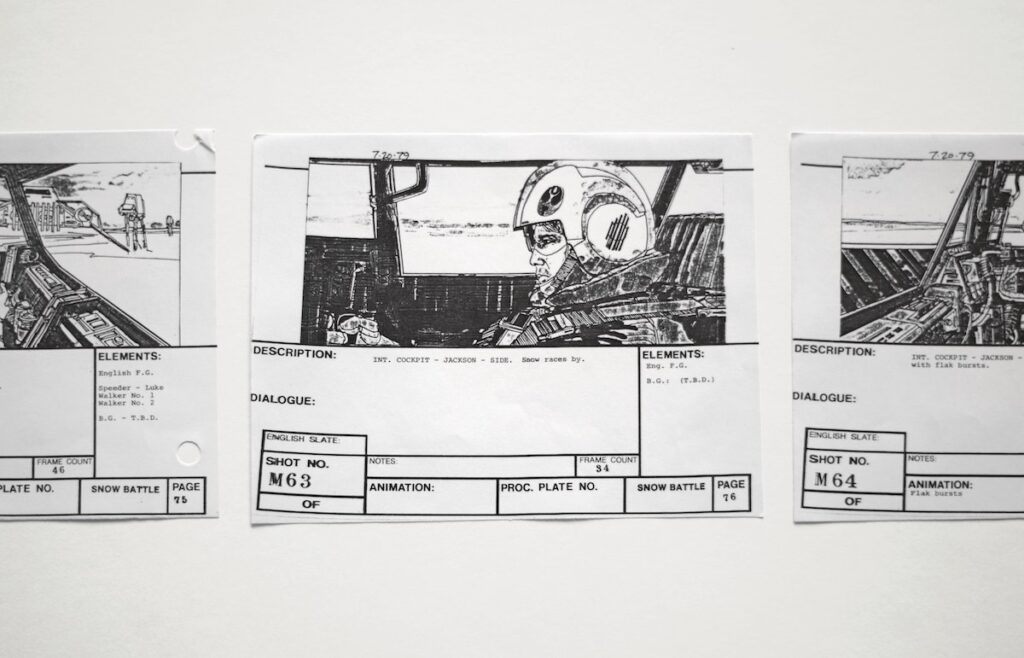Are you a comic book fan? Love graphic novels? Storyboard artist might be the career for you.
Storyboard artists work with directors and producers to visually interpret a script or concept by creating a series of illustrated image panels called storyboards — similar to a comic strip. They are the visual translators of a story, and their work becomes the roadmap for production.
It’s a vital role because storyboard artists guide how others perceive the project. All members of a production or development team look at storyboards for reference — which is why the boards’ clarity is so critical. Storyboards also convey the energy and style from which art directors take their cue. The storyboard artist needs to give the look and feel of what will become the finished product, from a character’s gestures and emotions to the production design, while using minimal language. Storyboards are used by directors and producers to put a visual narrative in place that informs other departments — from camera crew to costume design to art direction — what they have to do in the production.
What does a storyboard artist do?
Storyboard artists are essential for many different types of productions — from animation to films, television commercials and ad campaigns, video games, app games, music videos, instructional videos, and more. The storyboard artist enters the picture after a concept or script has been created. The actual storyboard presents the “action” via a series of scenes depicted by individual panels that let filmmakers, marketing and advertising executives, producers, and directors “see” the project before commencing production. Storyboards are also used to give direction during the actual production.
In animation, storyboard artists create the “raw footage” of a project. They birth the vision of a script — pretty cool, right? Storyboard artists take a script and begin visualizing it by making drawings that depict each beat of the story, drawn in sequence on a timeline so that a visual structure is scaffolded to the script’s words and there begins to be something to “watch.”
How do storyboard artists create their work?
There are many different modes of creation — storyboard artists might draw scenes by hand or use computer illustration. Some might sketch in black and white while others produce full-color storyboards. Storyboarders work with a production or team from concept to project completion, sketching scenes during initial meetings and editing scenes as the project progresses.
Sometimes, storyboard artists are given a radioplay — an audio file with stand-in dialogue — so that they can fine-tune the timing to how the episode or project will actually play. Eventually, these illustrated montages are edited together to create a rough draft that is sometimes referred to as the “animatic.”
Methods vary from artist to artist — in many cases, the rest of the development or production team will influence the storyboard artist’s processes. For film or animation projects, the director may affect how a storyboarder renders their scenes. It’s great to have your own style, but flexibility is essential when working with a larger team. And if there is more than one storyboard artist on a team, often the various artists will mimic one another’s styles because the uniformity of the storyboards helps maintain the clarity of the vision.
Here are some key things that storyboard artists have to convey in their storyboards:
- Describe camera movement – Storyboards are a comic book of the finished project and show when the camera pulls back and when a close up is needed.
- Tell the story visually – A storyboard needs to clearly show what is happening, using minimal text. While technical descriptions have a place in the storyboard, the images should convey what is happening.
- Track narrative structure – Time is not linear in most films or animation stories. Storyboards have to make these transitions clear. In video games, a storyboarder may go beyond visualizing scenes as they are likely working on different levels within a game and an element of character design.
- Continuity – Storyboard artists are responsible for the visual continuity of a story.
Where do storyboard artists work?
There are extensive job opportunities for storyboard artists. Because the skillset lends itself to opportunities outside of entertainment, there is an inherent job malleability for those that master this type of illustration. Here are some of the diverse places that employ storyboarders:
- Film studios
- Game development companies
- Animation studios
- Advertising agencies
- Graphic design and marketing agencies
- Architecture firms
- Some governmental agencies
What attributes do you need to succeed as a storyboard artist?
- Excellent Illustration skills. As you might suspect, superb drawing skills are essential. Storyboards need to clearly convey a scene and the emotions and gestures of the characters therein.
- Understanding of cinematography. It’s key to know a bit about cinematography as you will be drawing what the “camera” will see. While video games and animated films aren’t filmed with a camera per se, the imagery still has a point-of-view perspective. What a camera sees and what our eyes see are distinct — you’ll need to know and understand the difference.
- Ability to interpret other people’s ideas. The name of the game is translating scripts and written concepts into a visual form — the ability to discern meaning and texture within the language and bring it to life is the heart of storyboarding.
- Excellent storytelling skills. Storyboard artists are creating visual narratives for the written word, a deep understanding of how to tell a story is vital.
What are the key responsibilities of a storyboard artist?
- Read the script and meet with the director or producer to discuss mood, design, and overall theme.
- Make sketches of crucial scenes in sequence.
- Maintain narrative continuity (aka keeping story details connected)
- Visualize scenes from the camera’s viewpoint; plot character emotions, gestures, angles, overall mood, along with wardrobe or prop requirements in each frame.
- Detail shots and action scenes before shooting so that the production can use the storyboard as a roadmap. You know the adage: measure twice, cut once — storyboards help avoid reshoots and going over budget.
- Amend scenes to reflect changes in the script or comments from the producer or director.
What qualifications do you need as a storyboard artist?
You should have:
- A creative mind
- Excellent illustration skills and the ability to draw and work quickly
- The ability to interpret other people’s ideas
- Superb storytelling skills
- Solid understanding of cinematography, film theory, and production
- In-depth knowledge of human form, gesture, and motion — along with excellent layout and composition skills
- A great sense of timing, sequential drawing, and story editing
- Be able to use computer illustration software *
PRO-TIP: Take art, theatre, cinema, and photography courses. Every element of the creative production process you understand will make you that much more valuable as a storyboard artist.
How much do storyboard artists make?
The average annual salary for storyboard artists is approximately $114,300 and ranges from $85,000 to $149,000.
* The best storyboard software in 2020
- StudioBinder
- Moviestorm
- FrameForge
- ShotPro
- Storyboard Quick
- Storyboard Artist Studio 7
- Toon Boom StoryBoard Pro
- Storyboard Fountain
- Storyboard Composer
- Storyboard That
- FrameForge 4
- Boardo
About the author.
An award-winning creator and digital health, wellness, and lifestyle content strategist — Karina writes, edits, and produces compelling content across multiple platforms — including articles, video, interactive tools, and documentary film. Her work has been featured on MSN Lifestyle, Apartment Therapy, Goop, Psycom, Pregnancy & Newborn, Eat This Not That, thirdAGE, and Remedy Health Media digital properties.




